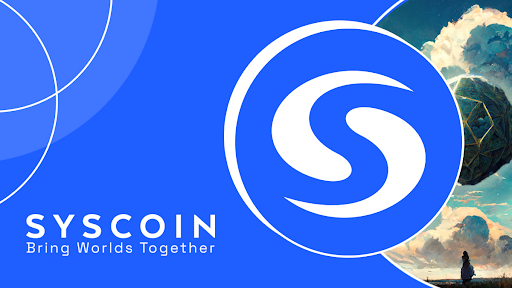Syscoin’s holistic approach has made it one of, if not the most complete blockchain projects in existence as it aims to solve a broad scope of the hurdles faced by the industry in order to clear the way towards mass adoption. Syscoin essentially seeks to offer the best of Bitcoin and Ethereum together in one place while making many of its own improvements. Through its commitment to Bitcoin’s PoW security, the flexibility of Ethereum, and what is currently slated to be the world’s first blockchain ecosystem with rollups and Proof-of-Data Availability, Syscoin aims to onboard the entire world into the Web3 space.
Syscoin is a modular blockchain due to its application of two Layer 1s, their UTXO-based Core chain and their EVM-compliant NEVM (Network Enhanced Virtual Machine) chain. This allows them to gain the strengths of both Bitcoin and Ethereum while making several improvements across the board. In the end, or at the beginning depending on how you look at it, both sides are settled by Bitcoin’s PoW through a process called merged mining.
Merged mining was originally discussed on the Bitcoin forums by Satoshi himself as a way to allow Bitcoin miners to share the security they earn for Bitcoin with a secondary network. Syscoin has utilized this ingenious method in combination with the additional security and utility they gain from Z-DAG and their Masternode network.
Z-DAG allows for high transfer throughput of 50k or more TPS. Additionally, Masternode network, which is run through a non-custodial lock of 100k of Syscoin’s native token, SYS, protects the Syscoin network from 51% and Selfish Mining Attacks, while also providing finality and multi-quorum chainlocks to prevent rollbacks, while rewarding their owners with freshly minted SYS.
However, the latest exciting Syscoin innovations are happening on the NEVM side of the network, which went live on December 6, 2021. The Syscoin Team foresaw how integral scalability would be for Web3 to reach the masses, which is why they have been building with rollups and their unique PoDA (Proof-of-Data Availability) solution in mind. Their NEVM’s Layer 2, named Rollux, is scheduled to release in Q1 2023 as these innovations complete their testnet trials and enter mainnet.

The Rollux roadmap currently includes Optimistic & ZK-Rollups, Proof-of-Data Availability, Validium, and DAOSYS, all of which play an integral role in Syscoin’s rise to prominence. Since Syscoin’s NEVM is programmed in the Solidity language, and is 100% compatible with smart contracts and rollups built for Ethereum. This provides an open invitation for dApps developed for Ethereum to easily port to Syscoin in order to gain the benefits of Bitcoin’s PoW security, greater decentralization, and the scale that comes from increased speeds and cheaper transactions.
Validium is an upgrade for ZK-Rollups, which will allow them to operate even more efficiently. This paves the way towards a future where the number of smart contracts Syscoin will be able to run simultaneously becomes arbitrary, paving the way for the Metaverse, Smart Cities, IoT, and even an interplanetary civilization.
DAOSYS is much more than a Decentralized Autonomous Organization. It is a DAO model to allow for the decentralization and automation of enterprise practices, and the Syscoin Foundation will use it for themselves once it’s ready to serve as a proof-of-concept. However, it is also being designed as a Blockchain Operating System (BOS), which will standardize the development process by giving developers the tools and shortcuts they need to to build smart contracts and dApps far more quickly, saving countless hours in the process.
Syscoin’s major breakthroughs that make it the most ready platform to support mass scale comes from a combination of rollups and its own PoDA solution. Rollups scale transactions by essentially compressing a multitude of transactions together and treating them as though they were just one. Meanwhile, there must be a way to verify each transaction within the rollup contains all the data it is meant to relay without sacrificing decentralization.
Interestingly enough, although many projects are singing the praises of rollups, few mention their plan for how to address proving data availability. Currently, Ethereum is the only other project to have proposed a solution via proto-danksharding, which has striking similarities to Syscoin’s straightforwardly named, Proof-of-Data Availability. However, proto-danksharding is at least a year away, whereas PoDA, alongside rollups, is already on testnet and set to debut on the mainnet next quarter. The future awaits, but with Syscoin, it’s nearly here. If you are tired of waiting for the scalability and affordability needed to make your Web3 project a success, we invite you to join us.
*Illustration of Syscoin’s Architecture
About
Syscoin is a decentralized and open-source project founded in 2014 whose NEVM blockchain combines the best of Bitcoin and Ethereum in a single coordinated modular platform. Syscoin is ushering in the next step in the evolution of blockchain technology, providing Bitcoin’s proven security and Ethereum’s Turing-complete programmability elevated to true scalability via Optimistic, ZK-Rollups, Cross-chain ZK-Rollups and other Layer 2 technologies.
Website | Discord | Telegram | News | Github | YouTube | Facebook | Twitter | Instagram

















